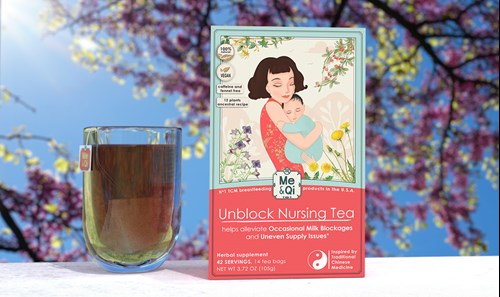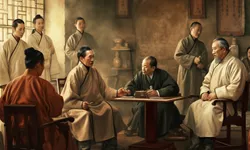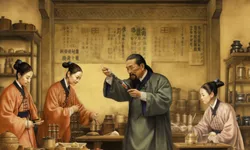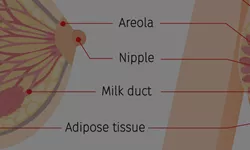What Is A Milk Blister?
A milk blister is what happens when a piece of skin or hardened breast milk blocks the nipple pore and milk duct, causing milk to build up behind it. It mostly happens during breastfeeding.
Milk blisters make it hard for milk to come out of the nipple pore, which can lead to clogged milk ducts or breast infection such as mastitis.
These blisters usually manifest as a clear, red, dark or white spot on the nipple, areola or breast, with pain concentrated in that area and the surrounding region. Applying pressure to the breast or chest to push milk down the ducts often causes the blister to protrude.
While milk blisters can persist for several days or even weeks, they generally heal on their own once the skin peels away from the affected area. Nursing or milk expression can sometimes alleviate the condition.
Milk Blister Pictures: Signs And Symptoms
How do you know if you have a milk blister? Here are some milk blister pictures to show the signs and symptoms:
- Nipple Bump Of Various Colors
Milk blisters typically appear as small bumps on nipple. They can be painful to the touch and may feel like a small lump. They may be of different colors.
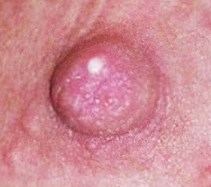
White Blister On Nipple
-
- Yellow or white blisters
Most common milk blisters appear as small white or yellowish spots on the nipple, about the size of a sesame. They may look like whitehead pimples as shown in the picture. Also, the skin around the milk blister can become red and it may hurt to nurse. In the case of an infection like mastitis, the color of milk blisters may become darker, such as a brownish hue.
Several factors can contribute to the formation of white or yellow blisters, such as:
-
-
- Clogged nipple pore or duct:
-
Sometimes, a tiny opening in the nipple can become clogged with dried milk or skin cells, leading to the formation of a white or yellowish blister.
-
-
- Friction blisters:
-
Improper latching or aggressive sucking by the baby can cause friction blisters on the nipple, which can be white or yellow color and painful.
-
-
- Infection:
-
Bacterial or fungal infections like thrush disrupt the skin's microorganism balance, causing inflammation and irritation. This leads to the formation of white or yellowish blisters on the nipple, filled with pus or fluid.
-
-
- Herpes:
-
Herpes simplex virus can cause fluid-filled bumps or blisters, which can break open and become painful sores that appear yellowish in color.
Please be aware that hormonal changes during pregnancy can cause the montgomery glands around the nipple to enlarge, which can sometimes be mistaken for yellow or white blisters. These glands release substances to lubricate the nipples and prepare them for breastfeeding.
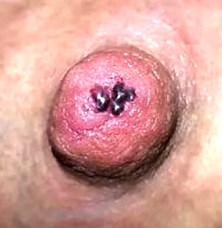
Blood Blister On Nipple
-
- Bloody blisters / Red blisters
A bloody blister or red blister on the nipple can be a sign of a nipple injury, such as a cracked or sore nipple, and is often seen in breastfeeding mothers. This type of blister is filled with blood instead of clear fluid and appears as a raised, bloody red area on the top of the nipple skin, as shown in the picture.
It is also known as friction blister breastfeeding, can be caused by friction or trauma during breastfeeding due to improper latch or positioning of the baby on the breast.
Shallow latch, poorly fitted nipple shields or pump flanges, and individual anatomy differences can all increase the likelihood of developing a blood blister.
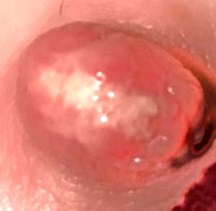
Clear Blister On Nipple
-
- Clear blisters
A clear blister on the nipple would appear as a small, raised area on the skin that is filled with clear fluid. It may be slightly transparent and have a shiny or glossy appearance.
Clear blisters can be caused by a variety of factors from the blocked glands to development of small cysts. However, the most common causes include: friction, pressure, or injury to the nipple, such as from breastfeeding, pumping, or wearing tight clothing.
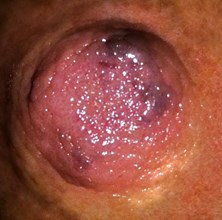
Dark Blister On Nipple
-
- Dark blisters
In cases when milk blisters stay for a long time or left untreated, post-inflammatory hyperpigmentation develops which eventually led to the appearance of a dark spot on the nipple.
Clear blisters can be caused by a variety of factors from the blocked glands to development of small cysts. However, the most common causes include: friction, pressure, or injury to the nipple, such as from breastfeeding, pumping, or wearing tight clothing.
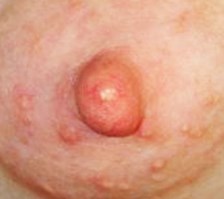
Blister On Areola Or Breast
- Bumps or Pimples on Areola Or Breast
Bumps on areola or breast rarely occurs, but if it does, it typically appears as a small bump filled with fluid on the skin surrounding the nipple. You can also see small pimples like spots present on both the top of the nipple and areola in the picture. Some redness can also be seen in the picture along with the spots.
The causes of breast or areola blisters are similar to those of nipple blisters, including friction from clothing or breastfeeding, poor latch or positioning during breastfeeding, use of poorly fitting nipple shields or breast pump flanges, as well as skin irritation or inflammation. Certain medical conditions, such as herpes or eczema can also cause blisters on the areola.
- Redness or Inflammation
As the milk blister develops, you may notice redness or rash around the affected area. This can be a sign of infection or inflammation.
- Sharp And Shooting Pain While Breastfeeding
For many nursing mothers, milk blisters can cause considerable pain and discomfort. This sharp and stabbing pain arises when a milk blister obstructs a milk duct, leading to milk buildup deeper within the breast. The pain typically worsens when the blister becomes aggravated during the breastfeeding process.
- Soft to touch
When touching a blister, it may feel soft and slightly squishy, especially if it is filled with fluid. This is true for fluid filled blisters. The pressure from the trapped fluid can cause a small bump to form, which may feel soft when pressed.
How To Treat Milk Blisters And Its Symptoms?
To effectively treat milk blisters, there are several methods you can try. Apply a warm compress for 10-15 minutes to open blocked milk ducts before breastfeeding and then apply cold compress to relieve pain after the feeding.
Nursing or pumping with a high-grade setting more frequently can prevent further milk build-up and clear blockages. Nipple shields can also protect the breast skin from baby aggressive suckling, helping in healing of the blister and lanolin creams can soothe the painful breast skin.
In case of infection, antibiotics may be recommended by a doctor. It is also important to wear a comfortable, well-fitting bra to avoid friction or pressure on the breast skin.
If the above methods do not provide relief, another option is to pop up the milk blister by a professional or at home. Check out this detailed article to learn how.
Finally, a mother can use Unblock Nursing Tea to provide relief. It is a blend of natural cooling herbs such as licorice, goji berry, dandelion, and honeysuckle flowers that helps in reducing the Toxic Heat in the body which is often the underlying cause of milk blisters. This tea not only helps in treating the milk blisters but it also aids in reducing surface symptoms such as breast swelling, redness, and itching.
For severe pain, it is recommended to use three tea bags per day.
Milk Bleb vs Milk Blister
Milk blebs and milk blisters are terms often used synonymously to describe a common breastfeeding issue caused by clogged milk ducts, frictions, or infection. It results in a small, raised bump on the nipple. The variation in terminology is mostly due to cultural and linguistic preferences among individuals.
However, some people claim that milk blisters are elevated, fluid-filled cutaneous lesions. They somewhat resemble blisters, with the exception that the blistering region contains visible, trapped fluid. When pressure is applied to a milk blister, the skin of the blister will bulge.
This differs slightly from a bleb, in which the skin remains flat, they do not contain fluid. Milk blebs have an uneven shape and will flatten under pressure. While milk blebs may be apparent, they are typically not painful. Yet, some women suffer pain when breastfeeding.
The milk blister may be transparent, dark, red, or white in color as shown in above pictures, while milk blebs are mostly white, but they can also appear light yellow or pink in color.

